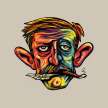The Future Impact of AI on Web and Graphic Designers and Photographers
Where the development of AI will take us

Introduction to AI in Creative Industries
Artificial Intelligence (AI) has become an integral part of various industries, including the creative sector. From web design and graphic design to photography, AI technologies are revolutionizing the way professionals approach their craft. AI, in its simplest form, refers to the simulation of human intelligence in machines programmed to think and learn like humans. The concept of AI dates back to the mid-20th century, but it is in recent years that we have witnessed remarkable advancements, particularly in creative fields.
Historically, creative tasks have been perceived as inherently human, requiring a blend of imagination, intuition, and emotional intelligence. However, modern AI systems are challenging this notion by demonstrating capabilities in areas such as image recognition, natural language processing, and even artistic creation. Tools like Adobe Sensei and Google's DeepDream are prime examples of how AI can augment the creative process, offering new tools and techniques that were previously unimaginable.
The rapid development of AI technologies is largely driven by improvements in machine learning algorithms, increased computational power, and the availability of vast amounts of data. These advancements enable AI to analyze patterns, generate content, and even make design suggestions, thereby streamlining workflows and enhancing productivity. For instance, AI can automate repetitive tasks, allowing designers and photographers to focus more on the conceptual and emotional aspects of their work.
Despite the promising potential of AI, its integration into creative industries has been met with both excitement and apprehension. On one hand, AI offers unprecedented opportunities to push creative boundaries and achieve higher efficiency. On the other hand, there are concerns about job displacement, the loss of human touch in creative works, and ethical considerations regarding AI-generated content. These mixed reactions underscore the transformative yet contentious nature of AI in the creative sector, setting the stage for a deeper exploration of its future impact on web and graphic designers and photographers.
AI Tools and Technologies Shaping Web and Graphic Design
In recent years, artificial intelligence has become a transformative force in the fields of web and graphic design. AI-driven tools and technologies are now integral to various aspects of the design process, from layout creation to color scheme generation and beyond. Among the prominent examples of these innovations is Adobe Sensei, an AI and machine learning framework embedded in Adobe's suite of creative tools. Adobe Sensei assists designers by automating repetitive tasks, suggesting design elements, and even predicting user preferences, thereby enhancing both creativity and efficiency.
Another notable AI-powered platform is Canva, which has integrated sophisticated AI features to simplify the design process for users of all skill levels. Canvas AI capabilities facilitate the automatic arrangement of design elements, recommend color palettes based on the user's content, and provide a range of templates that adapt dynamically to user inputs. This not only speeds up the workflow but also ensures a higher quality of design output, even for those with minimal design experience.
AI-based prototyping tools like Figma and Sketch have also revolutionized user experience (UX) optimization. These tools leverage AI to analyze user interactions, generate wireframes, and create high-fidelity prototypes that can be tested and iterated rapidly. By employing AI, designers can focus more on creative problem-solving and less on manual adjustments and repetitive tasks.
While AI tools offer numerous benefits, such as improved design quality and accelerated workflows, they also come with potential limitations and ethical considerations. One significant concern is the potential for AI to facilitate the plagiarism of creative works, which raises questions about copyright and intellectual property. Additionally, there is an ongoing debate about the role of AI in the creative process and whether it might eventually diminish the human element that is intrinsic to artistic endeavors.
Overall, AI tools and technologies are reshaping the landscape of web and graphic design by enhancing creativity, streamlining processes, and improving the quality of design work. However, it is crucial for designers to remain aware of the ethical implications and limitations associated with these advancements as they continue to integrate AI into their creative workflows.
AI's Role in Modern Photography
In recent years, artificial intelligence has made significant strides in the field of photography, revolutionizing how images are captured, curated, and edited. One of the most notable advancements is the development of AI-powered cameras, which utilize machine learning algorithms to enhance image recognition and processing capabilities. These smart mirrorless cameras can automatically adjust settings such as exposure, focus, and white balance, ensuring optimal image quality without the need for manual intervention. By leveraging AI, photographers can achieve stunning results with minimal effort, allowing them to focus more on creativity and less on technical details.
Another key area of AI's impact is in automated photo curation. Sophisticated algorithms can now analyze large collections of images, identifying the best shots based on various criteria such as composition, lighting, and subject matter. This technology not only saves time but also helps photographers organize their portfolios more effectively, ensuring that the most compelling images are highlighted. Additionally, AI-driven tools can assist in selecting photos for specific purposes, such as social media posts or professional presentations, further streamlining the workflow for photographers.
AI has also transformed the landscape of photo editing with advanced software like Luminar AI. This cutting-edge application employs AI to perform complex editing tasks, such as enhancing colors, removing unwanted objects, and retouching portraits with unprecedented precision. By automating these processes, photographers can achieve high-quality results quickly and efficiently, freeing up time for other creative pursuits. The integration of AI in photo editing software has democratized access to professional-grade tools, enabling photographers of all skill levels to produce exceptional work.
While the rise of AI in photography presents many benefits, it also raises concerns about job displacement. As AI continues to automate routine tasks, the role of traditional photographers may evolve, requiring them to adapt to new technologies and workflows. However, this shift also opens up new opportunities for creative expression, as photographers can leverage AI to push the boundaries of their art. Ultimately, the future of photography will likely be characterized by a harmonious blend of human creativity and artificial intelligence, leading to innovative and inspiring visual experiences.
Future Trends and Predictions
The integration of Artificial Intelligence (AI) in web design, graphic design, and photography is poised to revolutionize these fields, bringing about profound changes in workflows, roles, and skills required by professionals. As AI technology continues to advance, its capabilities in automating routine tasks, generating creative content, and enhancing efficiency are expected to grow exponentially. Designers and photographers will likely see AI-powered tools becoming indispensable assets in their toolkits, offering unprecedented creative possibilities.
One significant trend is the increasing use of AI in automating design processes. AI algorithms can now generate website layouts, suggest color schemes, and even create logos based on minimal input from users. This automation can expedite the design process, allowing designers to focus more on strategic and creative aspects rather than repetitive tasks. Similarly, in photography, AI-driven software can automatically enhance images, remove imperfections, and even suggest the best compositions, enabling photographers to achieve professional results with greater ease.
However, alongside these optimistic predictions, there are also challenges to consider. A growing reliance on AI could potentially lead to a loss of the human touch that characterizes unique and personalized designs. Ethical dilemmas may arise concerning the ownership of AI-generated content and the potential for AI to perpetuate biases present in its training data. As AI becomes more integrated into creative fields, it will be crucial for professionals to maintain a critical eye and ensure that human creativity and ethical considerations remain at the forefront.
To stay relevant in this evolving landscape, continuous learning and adaptation will be essential. Designers and photographers must become proficient in using AI tools while also honing their unique creative skills that cannot be replicated by machines. Embracing lifelong learning, staying updated with the latest technological advancements, and developing a hybrid skill set that combines technical proficiency with creative expertise will be key strategies for thriving in the future of AI-enhanced design and photography.
About the Creator
Enjoyed the story? Support the Creator.
Subscribe for free to receive all their stories in your feed.






Comments
Andrea R is not accepting comments at the moment
Want to show your support? Send them a one-off tip.